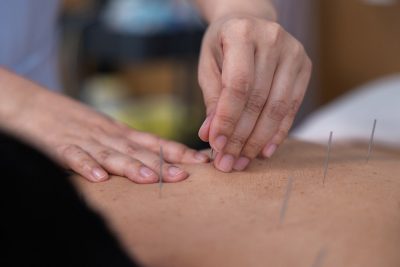
Acupuncture to Treat Low Back Pain in Older Adults
November 1, 2025
By Joshua Weaver, MD
Synopsis: A multisite, three-arm, parallel-group randomized clinical trial of older adults in the United States with chronic low back pain found improvement in both pain and disability with the addition of acupuncture treatment compared to usual medical care alone.
Source: DeBar LL, Wellman RD, Justice M, et al. Acupuncture for chronic low back pain in older adults: A randomized clinical trial. JAMA Netw Open. 2025;8(9):e2531348.
Low back pain is the leading cause of disability worldwide and the most common reason for patients to see their primary care physician. Both the burden of disease and the prevalence increase with age, with about 36% of older American adults experiencing low back pain.1 Usual medical care consists of physical therapy, medications, and injections. Acupuncture has been well-studied and has shown benefit in the treatment of low back pain; however, this is the first large study that has looked at the efficacy of acupuncture in the older population.2
A total of 800 adults older than 65 years of age with chronic low back pain were recruited from three regions in the United States and randomized to one of three arms: usual medical care (UMC), standard acupuncture (SA) treatment (eight to 15 sessions over three months plus UMC), and enhanced acupuncture (EA), which consisted of the SA protocol plus four to six additional acupuncture sessions over the following three months. More than 50 acupuncturists were recruited from the community. A flexible needling protocol was used to tailor to the individual patient.
Participants in the study had nonspecific back pain with or without pain radiating into the legs. The mean age of participants was 73.6 years, with 62% women. The treatment groups were similar except for some small differences in race and ethnicity, income, proportion with high-impact chronic pain, and presence of sciatica.
The primary outcome was back pain-related disability rated by a validated and patient-reported scale, the Roland-Morris Disability Questionnaire (RMDQ), completed at baseline and months 3, 6, and 12. Secondary outcomes included pain intensity, percentage of patients with clinically meaningful improvement in either pain or disability (> 30% improvement from baseline), a scale detailing the patient’s impression of change in pain, physical and social functioning, and anxiety levels.
At both six and 12 months, there was a significant reduction in disability noted on the RMDQ in both acupuncture groups compared to UMC, with no significant difference between the acupuncture groups. Regarding pain and the patient’s impression of change in pain, the acupuncture groups reported significant improvement compared to UMC, with EA showing relative benefit over SA. The percentage of patients with clinically meaningful improvement in pain-related disability also showed benefit of SA and EA over UMC at six and 12 months. When combining the two acupuncture groups compared to UMC, there was significant improvement in physical and social functioning at three months and significant reduction in anxiety at six and 12 months.
Serious adverse events were similar among groups, with only one case of cellulitis noted in the acupuncture group (considered possibly related ). Almost 10% of the acupuncture group participants noted minor adverse events, most commonly discomfort or pain at the needling sites.
Commentary
There is an increasing number of studies supporting acupuncture as a treatment for low back pain. Low back pain is a common condition with increasing prevalence and disability as people age. This is the first large study looking specifically at using acupuncture in an older population. This study shows that using acupuncture as an adjunct to UMC leads to reducing disability, pain, and anxiety, and increasing functionality compared to UMC alone. These benefits last for at least up to a year after treatment intervention. Adverse events were fewer and less severe than those typically seen in trials for pharmacotherapy.
Important strengths of this study include its large size, diverse subject population (racial, ethnic, and geographical), and randomized and blinded study design. The pragmatic study design of using a usual care comparator, community acupuncturists, and a flexible needling protocol help to mirror the real-world experience of patients seeking this treatment modality. However, this pragmatic design leads to a considerable limitation of not having a consistent treatment control group (either with pharmacological treatment or sham acupuncture), thus adding more variability and making it more difficult to determine true differences between treatment groups.
Another limitation of the study is that the investigators included all types of chronic back pain, including those with axial lower back pain and those with radicular pain radiating to the legs. Axial back pain may be the result of pathology in joints, ligaments, discs, nerves, and/or muscles. Radicular pain, such as sciatica, is caused by nerve root inflammation or compression. Different treatments may target these various pain generators differently; similarly, acupuncture may work well for some forms of back pain but not others.
Despite these limitations, this is an important study that adds to a growing body of literature supporting the use of acupuncture in the treatment of low back pain. Future studies could look at acupuncture for axial low back pain vs. sciatica to see if there are any differences in efficacy between these groups.
Joshua Weaver, MD, is Assistant Professor of Clinical Neurology, Weill Cornell Medical College.
References
1. Wong CK, Mak RY, Kwok TS, et al. Prevalence, incidence, and factors associated with non-specific chronic low back pain in community-dwelling older adults aged 60 years and older: A systematic review and meta-analysis. J Pain. 2022;23(4):509-534.
2. Lam M, Galvin R, Curry P. Effectiveness of acupuncture for nonspecific chronic low back pain: A systematic review and meta-analysis. Spine (Phila Pa 1976). 2013;38(24):2124-2138.